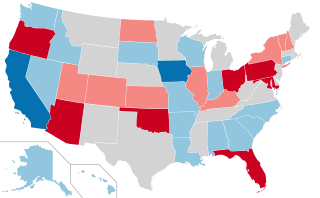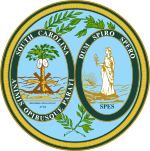
James Francis Byrnes was an American judge and politician from South Carolina. A member of the Democratic Party, he served in U.S. Congress and on the U.S. Supreme Court, as well as in the executive branch, most prominently as the 49th U.S. Secretary of State under President Harry S. Truman. Byrnes was also the 104th governor of South Carolina, making him one of the very few politicians to have served in the highest levels of all three branches of the American federal government while also being active in state government.

The 1968 United States Senate elections were elections for the United States Senate. Held on November 5, the 34 seats of Class 3 were contested in regular elections. They coincided with the presidential election of the same year. The Republicans picked up five net seats in the Senate. This saw Republicans win a Senate seat in Florida for the first time since Reconstruction.

The 1954 United States Senate elections was a midterm election in the first term of Dwight D. Eisenhower's presidency. The 32 Senate seats of Class 2 were contested in regular elections, and six special elections were held to fill vacancies. Eisenhower's Republican party lost a net of two seats to the Democratic opposition. This small change was just enough to give Democrats control of the chamber with the support of an Independent who agreed to caucus with them, he later officially joined the party in April 1955.

Coleman Livingston Blease was an American politician of the Democratic Party who served as the 89th governor of South Carolina from 1911 to 1915, and as a United States senator from 1925 to 1931. Blease was the political heir of Benjamin Tillman. He led a political revolution in South Carolina by building a political base of white textile mill workers from the state's upcountry region. He was notorious for playing on the prejudices of Poor Whites to gain their votes and was an unrepentant white supremacist.

The 1912–13 United States Senate elections were held on various dates in various states. They were the last U.S. Senate elections before the ratification of the Seventeenth Amendment in 1913, establishing direct elections for all Senate seats. Senators had been primarily chosen by state legislatures. Senators were elected over a wide range of time throughout 1912 and 1913, and a seat may have been filled months late or remained vacant due to legislative deadlock. Some states elected their senators directly even before passage of Seventeenth Amendment. Oregon pioneered direct election and experimented with different measures over several years until it succeeded in 1907. Soon after, Nebraska followed suit and laid the foundation for other states to adopt measures reflecting the people's will. By 1912, as many as 29 states elected senators either as nominees of their party's primary or in conjunction with a general election.

The 1908 South Carolina gubernatorial election was held on November 3, 1908, to select the governor of the state of South Carolina. Governor Martin Frederick Ansel faced state senator Coleman Livingston Blease in the Democratic primary and emerged victorious to win a second two-year term as governor.
The 1912 South Carolina gubernatorial election was held on November 5, 1912, to select the governor of the state of South Carolina. Governor Coleman Livingston Blease won the Democratic primary. As South Carolina was utterly dominated by the Democratic Party, he faced no significant opposition in the general election.

The 1916 South Carolina gubernatorial election was held on November 7, 1916, to select the governor of the state of South Carolina. Governor Richard Irvine Manning III faced a strong challenge from former governor Coleman Livingston Blease in the Democratic primary, but Manning won a second two-year term as governor.

The 1914 United States Senate election in South Carolina was held on November 3, 1914 to select the U.S. Senator from the state of South Carolina. It was the first election in South Carolina in which the voters were able to choose the candidate in the general election. Incumbent Democratic Senator Ellison D. Smith won the Democratic primary and defeated nominal opposition in the general election to win another six-year term.

The 1920 South Carolina United States Senate election was held on November 2, 1920 to select the U.S. Senator from the state of South Carolina. Incumbent Democratic Senator Ellison D. Smith won the Democratic primary and was unopposed in the general election to win another six-year term.

The 1926 South Carolina United States Senate election was held on November 2, 1926, to select the U.S. Senator from the state of South Carolina. Incumbent Democratic Senator Ellison D. Smith won the Democratic primary and was unopposed in the general election to win another six-year term.

The 1932 United States Senate election in South Carolina was held on November 8.

The 1936 South Carolina United States Senate election was held on November 2, 1936 to select the U.S. Senator from the state of South Carolina. Incumbent Democratic Senator James F. Byrnes won the Democratic primary and defeated two Republican candidates in the general election to win another six-year term.

The 1942 South Carolina United States Senate election was held on November 3, 1942 to select the U.S. Senator from the state of South Carolina. Incumbent Senator Burnet R. Maybank defeated Eugene S. Blease in the Democratic primary and was unopposed in the general election to win a six-year term.

The 1918 South Carolina United States Senate election was held on Tuesday, November 5, simultaneously with the special senate election to elect the United States Senator for a six-year term from South Carolina. Nathaniel B. Dial won the Democratic primary and was unopposed in the general election to win the six-year term to the Senate.

The 1924 South Carolina United States Senate election was held on November 4, 1924, to select the U.S. Senator for a six-year term from the state of South Carolina. Coleman Livingston Blease won the Democratic primary and was unopposed in the general election to win the six-year term to the Senate.

The 1913 South Carolina United States Senate election was held on January 28, 1913, when the South Carolina legislature met and unanimously ratified the results of the August 27, 1912 primary. Incumbent Senator Ben Tillman was re-elected to a fourth term in office.

Electoral history of James F. Byrnes, 49th United States Secretary of State (1945-1947), Associate Justice of the United States Supreme Court (1941-1942), United States Senator from South Carolina (1931-1941), 104th Governor of South Carolina (1951-1955) and United States Representative from South Carolina (1911-1925)

The 1932 United States Senate election in North Carolina was held on November 8, 1932. Interim Democratic Senator Cameron A. Morrison ran for election to a full term, but was defeated in the Democratic primary by Robert Rice Reynolds. Reynolds defeated Republican Jacob F. Newell in the general election.

A general election was held in the U.S. state of South Carolina on November 4, 2014. All of South Carolina's executive officers were up for election as well as both United States Senate seats, and all of South Carolina's seven seats in the United States House of Representatives.










